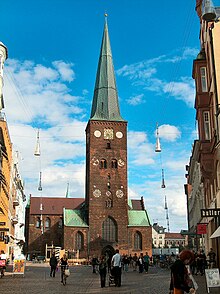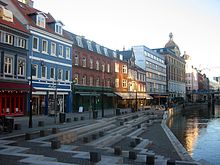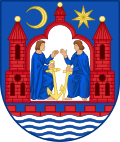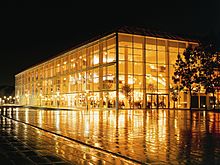Aarhus
|
Aarhus Aarhus |
||||
|
||||
| Basic data | ||||
|---|---|---|---|---|
| State : |
|
|||
| Region : | Midtjylland | |||
|
Municipality (since 2007) : |
Aarhus | |||
| Coordinates : | 56 ° 9 ' N , 10 ° 13' E | |||
|
Population : (2021) |
282.910 | |||
| Area : | 91 km² | |||
| Population density : | 3,109 inhabitants per km² | |||
| Height : | 105 m above sea level | |||
| Telephone code : | (+45) | |||
| Postal code : | 8000, 8100, 8200, 8210, 8220, 8229, 8230, 8240, 8245, 8250, 8260, 8270 | |||
| Mayor : | Jacob Bundsgaard | |||
| Sister cities : | look here | |||
| Website: | www.aarhus.dk | |||
 The Aarhus Cathedral in the city center |
||||
Aarhus or ([ ˈɒːhuːˀs ]; outdated Low German: Arenhusen ) in the Midtjylland region is Denmark's second largest city with 282,910 inhabitants (as of January 1, 2021) . It is located in the east of Jutland on Aarhus Bay . The municipality of Aarhus has a total of 352,751 inhabitants (as of January 1, 2021); the metropolitan region of Aarhus (Byregion Østjylland) almost 1.4 million.
The place goes back to a Viking settlement at the mouth of Aarhus Å . Aarhus was first mentioned as a bishopric in 948 and developed into a flourishing maritime trading town after the Middle Ages . Aarhus only recovered from the economic slump caused by the Thirty Years' War in the course of the 19th century with the onset of industrialization and the expansion of the port. As the center of a new road and railway network, the city developed into the economic center of Jutland and today has a diverse industry. The Aarhus Havn seaport is Denmark's largest container terminal .
The Aarhus University was founded in 1928 and in 1970 became a state university. In 2017 Aarhus was one of the European Capitals of Culture alongside Paphos .
geography
Aarhus is located on Aarhus Bay , which is part of the Kattegat between Jutland and the Swedish west coast. The city is about 40 km east of Silkeborg , 50 km north of Horsens and about 100 km south of Aalborg .
history
City history
The place was founded by the Vikings who settled in the mouth of the Aarhus Å River and has been inhabited continuously since then. The oldest spelling, Arus, dates back to 1231, formed from å (dt. River) and old Danish ōs (dt. Mouth), later converted to -hus (dt. House). The approximately four hectare settlement soon grew upstream towards Immervad and downstream to today's Mejlgade road ; it was surrounded by a rampart with a moat.
Recent excavations in Aarhus revealed that the city was founded around 770. According to this, Aarhus is at least 100 years older than previously assumed and one of the oldest cities in Northern Europe. After Haithabu and Dankirke near Ribe, it was the third city mentioned in the annals; it is said to have been the seat of a bishopric as early as 948 (see Diocese of Aarhus and List of Bishops of Aarhus ), although Harald Blauzahn was only baptized in 960. In 965 and 988 the name appeared again in German documents. The Vikings left six rune stones in the urban area . Coins have been struck in the city since 1040 .
In 1050 the Norwegian king Harald Hardråda attacked the city. Aarhus became a bishopric again in 1060. In 1070, the cathedral was built in the fast-growing town outside the wall in the new suburb. At the beginning of the 12th century, the next suburb and St. Oluf's Church were built north of the old ramparts. When Peder Vagnsen became bishop in 1191, this ushered in a new development, and in 1203 construction of the current cathedral began. The old cathedral was demolished and in its place the Frue Kirke and a Dominican monastery were built in 1235 . In 1477 the first section of the wall was razed for new buildings.
In the 16th and 17th centuries, Aarhus was a regionally quite important maritime trading town, but remained behind Copenhagen , Flensburg and Altona, which was founded in the 17th century, in the state as a whole under the Danish crown . It was not until the middle of the 19th century, when the city developed into the center of the new road and rail network, that Aarhus became the largest city in Jutland and soon outperformed rivals Randers and Aalborg . The loss of the duchies of Schleswig , Holstein and Lauenburg and thus the economic centers in the south of the previous state strengthened the city's position within Denmark.
The rapid growth continued in the 20th century and Aarhus developed into a big city. In 1928 Aarhus University was founded as the second university in Denmark. The city is also the seat of the Graduate School of Aarhus , the Aarhus School of Architecture , the University of Music, Aarhus and the plays and playwrights School at Aarhus Theater.
Name change
On October 27, 2010, the Aarhus City Council decided against the votes of the bourgeois parties and the Enhedslisten to rename the place name from January 1, 2011 from Århus in Aarhus . This name can be easily written on any keyboard based on the Latin script . With the measure, the politicians intended to position the city more strongly in international competition. Although a 1984 decree allows the municipal authorities to restore an old Aa spelling, the official spelling is decided by the Danish Language Commission ( Dansk Sprognævn ) and the Danish Place Name Commission ( Stednavneudvalget ). These are Århus retained as the main form while Aarhus will be included in the spelling dictionary in brackets.
Town twinning
Aarhus has the following city partnerships:
-
 Bergen , Norway
Bergen , Norway
-
 Gothenburg , Sweden
Gothenburg , Sweden
-
 Turku , Finland
Turku , Finland
-
 Qaqortoq , Greenland
Qaqortoq , Greenland
-
 Harbin , People's Republic of China
Harbin , People's Republic of China
-
 Saint Petersburg , Russia
Saint Petersburg , Russia
-
 Rostock , Germany
Rostock , Germany
-
 Kiel , Germany
Kiel , Germany
European significance
In 1960, the city of Aarhus was awarded the European Prize awarded for their outstanding efforts to European integration thoughts. On June 25, 1998, the Aarhus Convention was signed here, which since 2001 as the UNECE Convention has been the first international treaty that assigns environmental protection rights to every person .
At the end of September 2011, the city submitted its application to the Danish Ministry of Culture to be the European Capital of Culture for 2017. On August 24, 2012, Aarhus prevailed against Sønderborg (southern Denmark) and, following its official appointment by the EU Council of Ministers in spring 2013, it was named European Capital of Culture in 2017 .
Tourist Attractions


In the open-air museum Den Gamle By ("the old town") many old half-timbered houses can be visited. Also worth seeing are the Århus Cathedral with the high altar by Bernt Notke as well as the tombs and epitaphs of Thomas Quellinus , whose roots go back to 1201, and the Marienkirche with its crypt from the 11th century.
The town hall (1938–1941) by architect Arne Jacobsen with its 60 meter high bell tower and the university buildings (1933–1946) are examples of modern Danish architecture from the early 20th century.
The cityscape appears very inharmonious due to the rapid growth of the city. Apart from Den Gamle By , you can also find a few typical half-timbered buildings in Mejlgade, Vestergade and Skolegade.
- In the immediate vicinity of Musikhuset Aarhus is the ARoS Aarhus Art Museum , which houses a large number of works by national and international artists.
- The Dukketeater Svaliegen is the only professional paper theater in Denmark.
- To the north of the city center is the spacious university park , in which the faculty buildings of Aarhus University are located. The extensive park with its two lakes in the middle is a popular destination for Aarhusians in summer.
- In the southwest of the city is Marselisborg Castle , which is used as the residence of the royal family in summer. In the presence of the Danish Queen Margrethe II , the impressive changing of the guard parade takes place every day at twelve o'clock. The park around the castle can be visited for free when the royal family is not present. The equestrian statue of King Christian X stands on the cathedral square .
- Søsterhøj (telecommunication tower): In Aarhus there is a 216.1 meter high telecommunication tower, which is not accessible to the public, the Søsterhøj, which was built in 1956 as a hybrid tower (reinforced concrete tower with an attached transmission mast). Danmarks Radio broadcasts several VHF programs and the second television programfrom there.
- Museum Moesgård is located south of the city (in Højbjerg) .
- The Årslev Dolmen (Danish: Årslev-dyssen) is one of the few dolmens in the region that was not destroyed in connection with agriculture and the expansion of the city of Aarhus in Denmark.
Culture
- In Musikhuset Aarhus (1982), the main concert hall of the city, opera and symphony concerts.
- The Aarhus Cathedral opposite the Danish Skønvirkestil held Aarhus Teater , which opened in 1900 and has five stages.
- The Aarhus Symfoniorkester enjoys a reputation that extends beyond the borders of Denmark.
- Train and Voxhall are popular concert venues.
- The Aarhus Festuge , a major art and culture festival, is held every year in late summer .
- The Royal Academy of Music has locations in Aarhus and Aalborg .
- The Aarhus Jazz Festival with many open-air events takes place every July.
- With Dokk1 (opened in 2015, construction costs 100 million euros), Aarhus has the largest library in Scandinavia with around 30,000 m² . Design and planning come from Schmidt Hammer Lassen Architects .
media
Two major daily newspapers appear in Aarhus : the largest Danish daily newspaper, Jyllands-Posten , based in Aarhus-Viby, and Århus Stiftstidende , a regional newspaper that focuses on Aarhus and its hinterland. There are also two regional radio and television stations: the regional broadcaster P4 from Danmarks Radio operates a local radio station in the city called P4 Østjylland , which covers Aarhus and nine surrounding municipalities. And since 1986 the TV 2 channel has also had a regional studio here with TV 2 / Østjylland , whose programs were broadcast for the first time in 1990. In addition, students from Aarhus universities have been running the Danish university radio station Aarhus Studenterradio since February 1996 .
Denmark's largest training and research institute for journalism, Journalisthøjskolen (before 2008 Danmarks Journalisthøjskole ), is also based in Aarhus.
economy
Aarhus is the trading center of Jutland . The most important branches of industry are the machine and textile industries (e.g. the sporting goods manufacturer Hummel ). The port mainly exports agricultural products, while the main imports are coal and iron . Aarhus is the headquarters of the beverage company Royal Unibrew . With Stibo A / S , founded as a printing house in 1794, one of the oldest companies that is now internationally active in the software, IT and printing business is located in Aarhus.
traffic
railroad
As the largest city in Jutland , Aarhus is an important transport center. The most important Danish railway line runs from Frederikshavn via Aalborg to Aarhus and on via Fredericia and Odense to Copenhagen . The central station of Aarhus ( Aarhus Hovedbanegård / Aarhus H ) requires a head making , as only the railway line Aarhus Grenaa leads east. The main routes to Silkeborg and Viborg first branch off in Skanderborg and Langå, respectively .
Since December 9, 2007, Aarhus has been directly connected to the German ICE network on the main line towards Padborg with one pair of trains a day to Berlin via Hamburg and another pair of trains only to Hamburg on the ICE TD (diesel-electric) . When the timetable changed in December 2015, the route to Hamburg was switched to a train operated by the Danish MF (IC3) as Eurocity , and the direct connection to Berlin abandoned.
air
Aarhus regional airport ( IATA : AAR, ICAO : EKAH) is located about 36 kilometers from Aarhus in Tirstrup. It has two parallel runways in east-west direction, 10L / 28R with a length of 2777 m and 10R / 28L with a length of 2702 m.
road
The European route 45, Denmark's most important north-south connection, passes Aarhus to the west. An east-west motorway to Herning was completed in 2016. Well-developed country roads connect Aarhus with all important places in Central Jutland.
ship
The seaport is one of the largest in Denmark for both freight and ferry traffic. Currently (2014) it has the largest container port in the country: Over 50 percent of the container freight of all Danish ports is handled here.
Transportation
From May 13, 1884, there was a tram that was opened as a horse-drawn tram . From July 7, 1904, it was operated electrically. Local public transport was operated by Århus Sporveje from 1928 to the end of 2006 . The tram mentioned in the name never served more than two lines; In 1971 the company switched completely to bus transport .
Since 2007, the operator in the municipality of Aarhus Busselskabet has been part of the Midttrafik transport association , which covers the entire Central Jutian region.
The Aarhus Letbane light rail system integrates a tram in the urban area and two railway lines that lead to the surrounding area: the Aarhus – Grenaa railway to the north and the Aarhus – Odder railway to the south. The Aarhus Letbane went part way into operation. The last section opened on April 30, 2019.
bicycle
Bicycles are a widespread means of transport and the city also offers numerous services for tourists on bicycles, such as tourist bike routes and rental bikes.
You can drive through the entire city on specially designed lanes next to the carriageway. It is possible to rent bicycles at various points in the city . This works via a deposit system similar to that of shopping carts. For a deposit of 20 Danish kroner (approx. 3 euros) you can borrow the bikes indefinitely and return them to one of the many rental points in the city center.
The city is well connected to the national long-distance cycle routes and from Germany z. B. can be reached directly from Flensburg.
Long-distance buses
Long-distance bus transport has also established itself in Denmark . Flixbus and Kombardo Expressen connect Aarhus with destinations at home and abroad.
Sports
- Atletion (formerly Aarhus Idrætspark ): In the south of the city is the city's sports center, called Atletion , which has existed since 1920. The associated stadium, the NRGi Park , is used by the Aarhus GF football club , a multiple Danish champions and cup winners. The NRGi Arena is also part of the Atletion Sports Center . Handball and basketball teams from the country's top leagues play in the multi-purpose hall . In 2002 the Danish women's handball team became European champions here. The 2006 World Gymnastics Championships were also held in the NRGi Arena. In 2005, took place in the Atletion table tennis - European Championship instead.
- At the end of July / beginning of August 2006, the orienteering world championships took place in and around Aarhus .
- In August 2009 the AIDA indoor world championships in freediving with the three disciplines static, dynamic with and without fins took place in Aarhus .
- On May 21, 2018 (Whit Monday), Aarhus was one of 5 cities in Denmark that celebrated the 50th birthday of Crown Prince Frederik (May 26) as part of the Royal Run .
- From July 30th to August 12th 2018 the ISAF Sailing World Championships , the joint world championship for all Olympic and Paralympic sailing disciplines, took place in Aarhus .
Personalities
sons and daughters of the town
- Ole Rømer (1644-1710), astronomer
- Karl Verner (1846-1896), linguist, discovered in 1875 the Verner law named after him
- Sophus Bauditz (1850–1915), educator, author and playwright
- Julius Hoffory (1855-1897), Scandinavianist, Germanist and phoneticist
- Heinrich Petersen-Flensburg (1861–1908), German landscape and marine painter from the Düsseldorf School
- Max Heindel (1865–1919), Danish / American engineer, author, theosophist and Rosicrucian
- Henry Rambusch (1881–1954), football player
- Torben Meyer (1884–1975), actor
- Hans Hartvig Seedorff Pedersen (1892–1986), poet
- Ejner Federspiel (1896–1981), actor
- Erik Møller (1909–2002), architect
- Poul Jørgen Riis (1910–2008), archaeologist, etrusologist and university professor
- Børge Gissel (1915–2002), track cyclist
- Gabriel Axel (1918–2014), film director and screenwriter
- Thorkild Bjørnvig (1918–2004), poet, writer and translator of German poetry
- Niels Otto Møller (1920–1982), furniture designer and entrepreneur
- Kay Werner Nielsen (1921–2014), track cyclist
- Kai Winding (1922–1983), American jazz trombonist
- Else Marie Pade (1924–2016), composer
- Helle Virkner (1925–2009), actress
- Finn Haunstoft (1928-2008), canoeist
- Bent Conradi (* 1932), actor
- Louis Hjulmand (1932-2008), jazz musician
- Ole Krarup (1935–2017), politician
- Ole Henrik Laub (1937–2019), writer
- Leif Hjernøe (* 1938), writer and presenter
- Ole Lund Kirkegaard (1940–1979), children's author
- Preben Vang (1942–1986), percussionist and jazz musician
- Jørgen Hansen (1943-2018), professional boxer
- Gitte Hænning (* 1946), pop singer
- Flemming Bamse Jørgensen (1947–2011), musician, singer and actor
- Bjarne Stroustrup (* 1950), computer scientist
- Troels Wörsel (1950–2018), painter and graphic artist
- Anders Dahl-Nielsen (* 1951), handball player, coach and official
- Jacob Haugaard (* 1952), musician, comedian, singer, actor, formerly also a politician and member of parliament
- Steffen Brandt (* 1953), singer and songwriter of the band Tv2
- Poul Krebs (* 1956), rock musician and songwriter
- Klavs Hovman (* 1957), jazz musician
- Peter Madsen (* 1958), comic artist and film director
- Kasper Rorsted (* 1962), manager and CEO of Adidas AG since 2016
- Michael Trangbæk (* 1962), journalist and presenter
- Charlotte Bøving (* 1964), director and stage actress
- Frank Pingel (* 1964), soccer player
- Josephine Fock (* 1965), politician
- Lars Schandorff (* 1965), chess player
- Renée Toft Simonsen (* 1965), model and children's book author
- Janne Kolling (* 1968), handball player
- Charlotte Munck (* 1969), actress
- Stig Tøfting (* 1969), football player
- Jesper Bodilsen (* 1970), jazz musician
- Morten Ramsbøl (* 1970), jazz musician
- Ari Behn (1972–2019), Norwegian writer and at times Prince Consort
- Sebastian Blenkov (* 1972), cameraman
- Anne Mette Iversen (* 1972), jazz musician
- Katrine Madsen (* 1972), jazz musician
- Sissel-Jo Gazan (* 1973), writer
- Veronica Mortensen (* ≈1973), jazz singer
- Tayeb Braikia (* 1974), racing cyclist and cycling trainer
- Ida Kristine Nielsen (* 1975), bassist and songwriter
- Rikke Petersen-Schmidt (* 1975), national handball player
- Nicklas Schmidt (* 1976), composer
- Ida Corr (* 1977), singer
- Tina Dico (* 1977), singer and songwriter
- Jesper Jensen (* 1977), handball player
- Thomas Røll (* 1977), football player
- Casper Elgaard (* 1978), racing car driver
- Britta Andersen (* 1979), badminton player
- Julie Berthelsen (* 1979), Greenlandic singer, actress and television presenter
- Philip Andersen (* 1980), racing car driver
- Nicolai Iversen (* 1980), basketball player
- Signe Egholm Olsen (* 1980), actress
- Tommy Bechmann (* 1981), soccer player
- Inez Bjørg David (* 1982), actress
- Medina (* 1982), singer
- Anna David (* 1984), pop singer
- Maibritt Kviesgaard (* 1986), handball player
- Linea Søgaard-Lidell (* 1987), politician
- Line Damkjær Kruse (* 1988), badminton player
- Susan Thorsgaard (* 1988), handball player
- Mikkel Kirkeskov (born 1991), football player
- Christoffer Faarup (* 1992), ski racer
- Jakob Dybdal Abrahamsen (* 1994), athlete
- Viktor Fischer (* 1994), soccer player
- Yahya Hassan (1995–2020), poet and prose writer
- Nicklas Nielsen (* 1997), racing car driver
People with a relationship to the city
- Rudi Dutschke (1940–1979), spokesman for the West German student movement in the 1960s, died in Aarhus
See also
- Århus history (joke about the townspeople )
literature
- Århus Amt (ed.): Nature and culture guide for Århus County 1997 . Århus 1997, ISBN 87-90099-21-4 .
- HJ Madsen: Århus and the Vikings . Forhistorisk Museum Moesgård 1975
Web links
- Harald Brandt : Europe in the Viking City ( deutschlandfunk.de , Long Night , May 6, 2017)
- Article about new excavations in Aarhus
Individual evidence
- ↑ a b Statistics Banks -> Befolkning og valg -> BY1: Folketal January 1st efter byområde, alder og køn (Danish)
- ↑ a b Martin Johansen, Jonas Hvid: Byen skifter navn ( Memento from March 11, 2012 in the Internet Archive ) In Aarhus.dk , accessed on October 28, 2010 (Danish)
- ↑ byregionoestjylland.dk. Retrieved April 22, 2019 .
- ↑ Per Eilstrup et al .: Welcome to Denmark - A Complete Photo Tour , Grönlunds Forlag 2009, p. 40 f.
- ^ Page of the State University of Music, Aarhus. Retrieved September 13, 2010 (Danish).
- ↑ Århus eller Aarhus? . In: Dansk Sprognævn . 2011. Retrieved May 18, 2011.
- ↑ https://www.kn-online.de/Kiel/Aarhus-und-Kiel-unterzeichen-Staedtepart Partnerschaft
- ↑ Aarhus as the awardee. (No longer available online.) Archived from the original on November 29, 2011 ; Retrieved September 13, 2010 .
- ↑ Aarhus Municipality: Ansøgningen til Europæisk Kulturhovedstad er afleveret ( Memento of October 4, 2011 in the Internet Archive ) of September 30, 2011, accessed on October 28, 2011 (Danish)
- ↑ http://kum.dk/nyheder-og-presse/kulturnyt/2012/almindelig-side/aarhus-valgt-som-eu-kulturhovedstad-i-2017-/ ( page no longer available , search in web archives ) (Link not available)
- ↑ Svalegangens Dukketeater in Aarhus. Retrieved September 13, 2010 .
- ↑ Chr. DA Andersen on denstoredanske.dk, accessed on May 24, 2013.
- ↑ Jazzfest (Danish, English)
- ↑ Dirk Asendorpf: Modern library: sitting, playing, talking, (reading). In: Zeit Online. November 30, 2015, accessed October 1, 2016 .
- ↑ a b BauNetz Media GmbH: Scandinavia's largest library - Dokk1 opened by Schmidt Hammer Lassen in Aarhus. June 22, 2015, accessed April 22, 2019 .
- ↑ Simon Strauss: And where are the books here? In: FAZ.net . October 3, 2015, accessed October 13, 2018 .
- ↑ DR P4: Om P4 Østjylland , accessed on April 25, 2012 (Danish)
- ↑ TV2OJ's historie ( Memento from April 27, 2012 in the Internet Archive ), accessed on April 25, 2012 (Danish)
- ↑ Aarhus Student Radio , accessed on June 5, 2012 (Danish)
- ↑ History ( Memento from February 3, 2013 in the web archive archive.today )
- ↑ Airport information Aarhus - EKAH. August 2, 2010, archived from the original on September 28, 2007 ; Retrieved September 13, 2010 (Danish, English).
- ^ Port of Aarhus (Danish) ( Memento from May 16, 2013 in the Internet Archive ) Official website, accessed on March 29, 2012
- ↑ lund: Aarhus - Grenaa light rail line finally opened . In: Eisenbahn-Revue International 6/2019, p. 318.
- ↑ Through Aarhus by bike . In: VisitAarhus . ( visitaarhus.de [accessed on May 19, 2017]).
- ↑ Vejdirektoratets trafikkort. Retrieved May 19, 2017 (Danish).
- ↑ Henrik Lund: DSB går til kamp for passagererne: Customers shall be sent to cheap tickets. February 19, 2019, accessed January 26, 2020 .
- ↑ royalrun.dk: Om Royal Run, Danish , accessed on November 14, 2017
- ↑ Danes cheering: Aarhus wins World Cup rights. In: yacht.de. Tatjana Pokorny (May 10 , 2014 ), accessed on August 21, 2018 .
- ↑ Hempel Sailing World Championships Aarhus 2018. In: https://site-isaf.soticcloud.net/ . Accessed August 21, 2018 .






